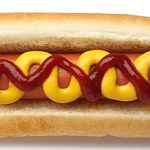by Lorette C. Luzajic
Today is National Hot Dog Day (at least in the U.S.) and I’m a girl without a grill. I don’t have a back yard or balcony, and so I have to rely on Dad for the thrill of the grill.
There’s no way I’ll skip celebrating the dawg.
What’s on my “classic” model? Why, the holy trinity, of course- mayo, mustard, and ketchup. My mom is fond of telling this story: when I was wee, we had a weenie roast at the cottage. There was no ketchup in stock. A babe cannot live by relish alone, and so I pulled a lifejacket over my head and clambered into the canoe. I paddled clear across the lake to ask our distant neighbours for ketchup. Mom always thought this would make a good ad for Heinz. Today I prefer President’s Choice Sugar Free, because I like a LOT of ketchup, but not a lot of carbs.
The classic dawg is delish, but there is much to be said for exploring the versatility of this simple staple.
Wait for a heat wave to serve the Hell Dog. It’s easy- just pile ‘er up with jalapeños and Provolone cheese. Brush whole jalapeños with olive oil, garlic and sea salt, and grill. These make a nice fiery side to any kind of sausage. If you’d rather not burn holes into your oesophagus, slice ‘em open first and discard the seeds.
Blue cheese fanatics love the Cobb- just top your dawg with lettuce, tomatoes, real bacon chunks, and a fine blue cheese crumble.
Low carb adherents love my “baked potato” dawgs- nothing but sour cream, fresh chives, and grated cheddar. No bun!
I like to get inventive with odds and ends in my kitchen so that I don’t waste food. This leftover methodology has yielded up some phenomenal recipes in my humble kitchen, and The Greek is one of them. I tossed leftover bits of horiatiki, or village salad onto my dawg. Village salad is real Greek salad, with big chunks of pepper, onion, cucumber, tomato, and black olives, with feta and olive oil.
Innovative leftover use is, in fact, how the hot dog came to be. Smart peasants used stretchy intestinal casings to fill with offal, organ meat, blood, and other flesh products, along with, occasionally, whatever other crumbs were available. The sausage was born.
The first recorded mention of sausages is nearly 3000 years ago, in Homer’s Odyssey. The ancient Greeks and Romans, peasants and emperors alike, prized the first “hot dogs” like nothing else.
But aren’t hot dogs bad for us?
Groups like the “Cancer Project” would like to rain out the ball games, calling for hot dogs to be labelled with cancer warnings. “Just as tobacco causes lung cancer, processed meats are linked to colon cancer… Companies that sell hot dogs are well aware of the danger, and their customers deserve the same information,” President Neal Barnard told the Los Angeles Times.
The “Cancer Project” is actually an arm of the “Physician’s Committee for Responsible Medicine” which is a vegan advocacy group in doctor’s clothing. Their brand of “responsible medicine” has come under fire time and time again for misrepresenting statistics and spreading misinformation to scare people into giving up the diet nature gave them. Their members have alliance with terrorist animal liberation groups.
If hot dog companies that stuff their dawgs with nitrites and other chemicals have to put cancer warnings on their food, then it’s time for all soy foods to mention their origin as industrial sludge and their aluminum, hexane, and estrogen content. It’s time for all sugar foods including whole grains to warn against diabetes. It’s time for human saliva and many vegetables to list nitrites, too. It’s time for all vegetable foods to wear labels reminding consumers that vitamins are fat soluble and that nutrients in plants are best absorbed with saturated fat like butter and meat. I’m all for it.
Flippancy aside, if you do consume a lot of sausages, choose the best your money can buy and stick to the ones whose ingredients you can pronounce. I also like to avoid gross sounding gunk like “mechanically separated meat.” There are quite a few at my supermarket that say simply “pork, water.” The Healthy Butcher and Rowe Farms, among other butchers, have amazing options.
Alarmist groups have also long bullied the humble hot dog for its alleged rat droppings, worms, bug bits and other yummy ingredients. Are hot dogs really full of ‘em?
Yes. But avoiding the wieners- or meat- won’t solve your worm worry. Bugs, rats, fly eggs, poo, and other ickies make up a percentage of everything you eat, from sausage to cinnamon. Sarah Krupp over at Chef’s Blade reports that, “Under the regulations in the FDA’s handbook, a hefty bowl of spaghetti is permitted 200 or so bug fragments—one for every gram of pasta—fifteen fly eggs, and a maggot. Add a pinch of FDA-acceptable ground oregano and it might be spiced with one hundred itsy bitsy bug bits and a rodent hair. And while hot dogs get a bad rap for the mystery meat parts ground up in them, you might want to take a closer look at the condiments. A few spoonfuls of sauerkraut could include fifty thrips—a small, slender bug pointed at both ends.”
So the bug thing is true, but what about the lips and ass? Aren’t hot dogs made of cow rectums?
Simpsons’ fans will recall Homer bemoaning his Kwik-E-Dog because it tasted different than usual. Store owner Apu tells him, “Yes, I just cleaned out the machine, sir, so the snack you are enjoying has not been soaking in putrid grease.” Homer whines that “without the grease, all you can taste is the hog anus.”
I spent far more time than is healthy looking up “pig rectum” and “hot dogs” on Google, but could not find a single source to confirm that this tasty tidbit is anything but a longstanding hysterical rumour.
Still, if Homer Simpson is right, it’s nothing to fear. Personally, I’d feel better about not wasting the humbler offerings of something that died for my food. Our revulsion to tongue, feet, organs, eyes, insects, blood and so on are culturally instilled. Our ancestors ate all parts of an animal, and they’re good for you… so don’t have a cow, man!
 Author, Artist, Poet Lorette C. Luzajic’s website is www.thegirlcanwrite.net. Browse her books at Amazon.ca.
Author, Artist, Poet Lorette C. Luzajic’s website is www.thegirlcanwrite.net. Browse her books at Amazon.ca.








